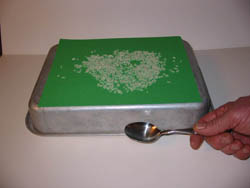Hello,
Our Kids Science Newsletter is published each month. The newsletter includes a question of the month, current science events, and a simple science activity that is fun for kids of all ages.
Question of the Month
How many legs does a centipede have?
(answer follows the simple science experiment)
Science Current Events
- Solar Storms Create Northern Lights
- This past month the strongest magnetic storms to strike Earth in eight years occurred in late January. These storms produced stunning pictures of Northern Lights lightning up the Northern Hemisphere. They are produced when magnetic storms on the Sun send out a stream of charged particles called the solar wind. After the solar flare sent a giant cloud of superheated gas and charged particles toward it took only 35 hours to reach our planet. The last time this strong a storm struck the Earth was in October 2003.
- Thieves Steal Tons of Glacier Ice
- Glacier ice from the Jorge Montt glacier was stolen by thieves wanting to sell it to bars and bottling it for drinking water. They had five tons of ice in a refrigerator truck when they were captured. The glacier is considered a cultural heritage and is part of the 5,000 square mile Southern Ice Field. It is the world's third largest ice cap. Only antarctica and Greenland have larger ice fields.
- Thousands Burmese Pythons Live in the Everglades
- Burmese pythons released by pet owners and others that escaped after Hurricane Andrew in 1992 are finding lots to eat. South Florida where most of the pythons live have nearly wiped out bobcats, oppossums, raccoons, and foxes living in South Florida. There has been a 99% decline in the sighting of medium-sized mammals living in these areas. It is estimated that tens of thousands of the snakes are living the waters but only about 300 to 400 are removed each year by hunters and game officials.
- Snowy Owls Fly South
- Snowy owls are being seen as far south as Seattle, Boston, Oklahoma and even Hawaii this year. There has been an over abundance of lemmings in the north causing the owl population to boom. Many owls raised as many as seven chicks because of the abundance of the lemmings. This winter the population is down and the owls are seeking food further south.
Science Trivia
- The oldest continuously standing tree on Earth is nearly 5,000 years old. This is about the same age as the pyramids of Egypt.
- Meteor shows occur when the Earth's orbit around the sun takes it through debris left over from the destruction of comets. Although the Earth's orbit aroundthe Sun is almost circular, most comets orbit in highly elongated ellipses. As a result some comets' obrits intersect or partially overlap Earth's path around the Sun.
- The humminbird, the loon, the swift, the kingfisher and the grebe are all birds that cannot walk.
- Jet streams are very strong winds blowing about 6 miles above the Earth. They can be up to 2,500 miles long but no more than 310 miles wide. They were not discovered until World War II when pilots found their air speed reduced when they were flying against the jet stream.
Simple Science Activity
Traveling Waves
Introduction
In this activity you will observe how energy waves created by striking a metal pan can travel through solids. Observe what happens to the rice as the energy waves reach the construction paper and the rice.

Materials
- Metal cooking pan
- Construction paper
- Rice
- Metal spoon
Directions
- Place a rectangular metal cooking pan on a flat surface upside down.
- Place a piece of construction paper on top of the pan.
- Scatter a small quantity of rice on the paper.
- Strike the side of the pan with a metal spoon.
- Watch the rice as you strike the pan.
- Repeat the activity several times hitting the pan with either more or less force.
- Try the activity with beans.
Science behind the experiment
Earthquakes occur when rocks under pressure break creating energy waves that travel through the Earth. The earthquake waves travel in all directions from the origin of the earthquake. When we feel the Earth shake we are feeling the energy waves as they pass below our feet.
Answer to the question of the month
How many legs does a centipede have?
If you guessed 100 because centi means 100 and therefore the animal must have 100 legs this is not necessarily true. The largest of the centipedes lives in tropical climates and can reach more than a foot in length. These giant centipedes have 340 legs. Most centipedes are much smaller and only average about 70 legs. Small centipedes are only about one inch long.
Please share the newsletter
Please share this newsletter with a friend by forwarding it to them. If you know of a group who might enjoy the newsletter please let them know about it also.
Comments? Ideas? Feedback? I'd love to hear from you. Just reply to this Just For Kids Science Newsletter and tell me what you think!
Sincerely yours,
Myrna Martin
Websites:
www.RingofFireScience.com
www.Kids-Fun-Science.com
www.Kids-Earth-Science.com
www.The-Science-Site.com
|



